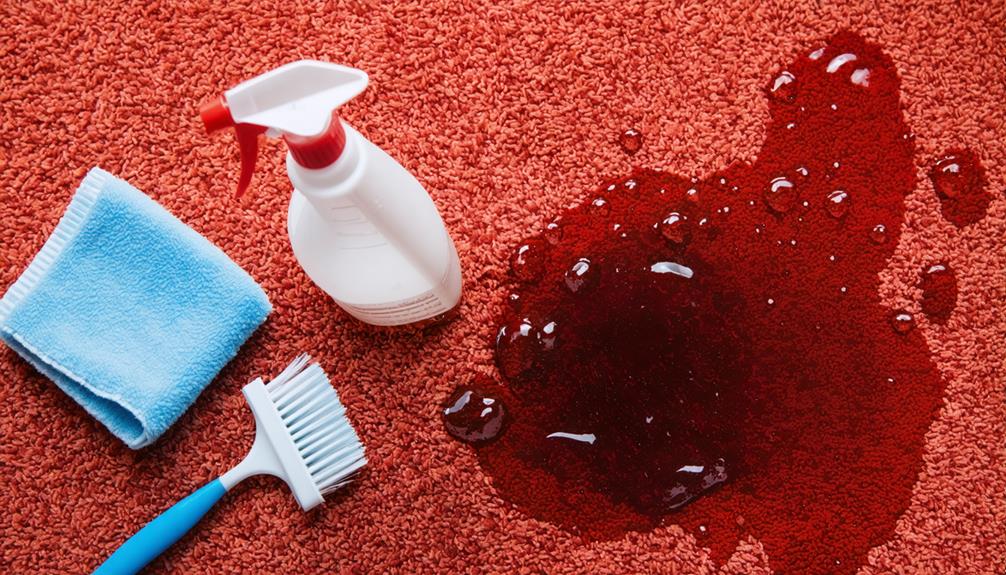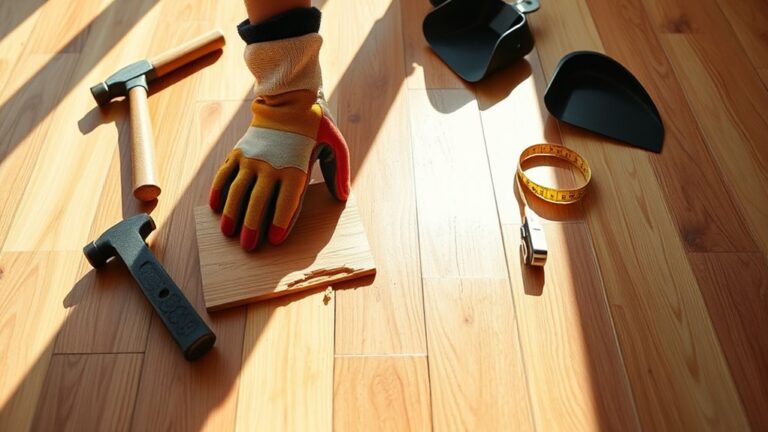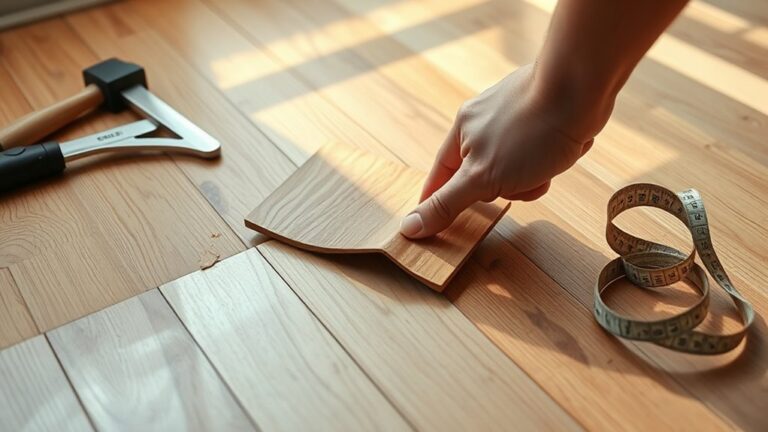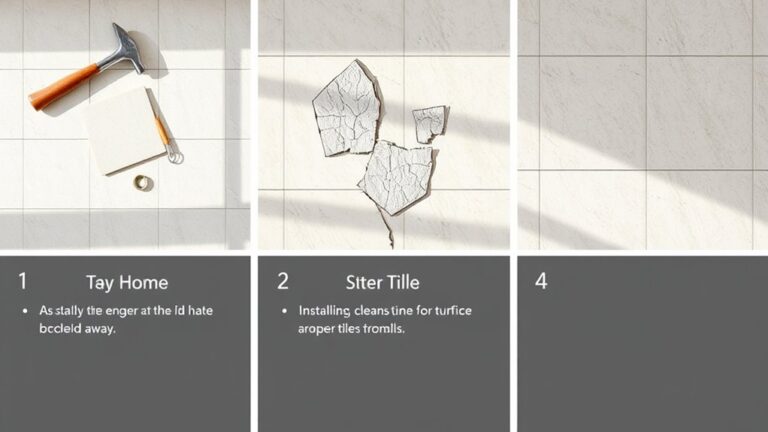To remove tough stains from carpet floors, start by identifying the stain type—water-soluble, oil-based, or protein-based. For water-soluble stains, mix vinegar and baking soda with water and blot gently. Oil-based stains may require a solvent cleaner; apply after absorbing excess oil. Protein-based marks, like pet urine, need enzymatic cleaners. Always blot from the outside in to prevent spreading. For old stains, rehydrate them with warm water before applying your cleaning solution. Regular maintenance, like vacuuming and prompt action on spills, can keep your carpet looking fresh—continue exploring to find specific solutions for common stains.
Understanding Carpet Stain Types
When it comes to tackling carpet stains, understanding their types is essential for effective removal. The types of stains can be categorized into three main groups: water-soluble, oil-based, and protein-based. Each of these requires a different cleaning approach, so knowing which type you're dealing with can save you time and effort.
Water-soluble stains, like those from beverages or mud, dissolve easily in water. For these stains, you can often use a mixture containing non-bleach detergent or vinegar to clean them up quickly. Simply blot the area, apply your solution, and rinse with water for the best results.
On the other hand, oil-based stains, such as cooking oil or grease, won't dissolve in water. Instead, you'll need a solvent-based cleaner or sometimes even the application of heat to remove these types of stains. Always check the cleaner's compatibility with your carpet before use to avoid damage.
Lastly, protein-based stains, which include blood or pet urine, require special attention. For these, enzymatic cleaners are your best bet, as they break down the proteins causing the stain.
Identifying the stain type is vital. If you treat a stain improperly, you might make it worse or damage your carpet fibers. So, take a moment to assess the situation and choose the right cleaning method for effective stain removal.
Essential Home Remedies
Once you've identified the stain type, you can move on to some effective home remedies. These solutions can help you tackle stubborn stains and even remove old stains, giving your carpets a fresh look without resorting to harsh chemicals. Here are some practical cleaning solutions you can whip up at home:
- Vinegar and Baking Soda: Mix ½ cup of each in a gallon of water. This powerful cleaning solution works wonders on various stains and is perfect for larger areas.
- Liquid Dishwashing Soap: Combine ¼ teaspoon with 1 cup of warm water. This gentle solution is safe for delicate fabrics and can be applied directly onto the stain using a spray bottle for easy application.
- Club Soda: Simply apply it directly onto the stain. Scrub gently with a brush, and for extra absorption, sprinkle a bit of salt on top. This method is especially effective for tough, old stains.
If you're dealing with light-colored carpets, hydrogen peroxide can be useful. Spray it directly onto the stain, but remember to test it on a hidden area first. For persistent or stubborn stains that these remedies can't handle, don't hesitate to reflect on hiring a professional cleaning service. They have specialized equipment and cleaning solutions that can restore your carpets effectively, ensuring they look their best for years to come.
Step-by-Step Stain Removal
Effective stain removal requires a clear approach to achieve the best results. Begin by identifying the type of stain, as they include water-soluble, oil-based, or protein-based. This step is essential for selecting the appropriate cleaning method.
For water-soluble stains, such as coffee or juice, mix 1/4 teaspoon of non-bleach detergent or white vinegar with 32 ounces of water. Blot the solution onto the stain using a clean cloth or paper, and then rinse with clean water.
If you're dealing with oil-based stains, like grease or makeup, first use a paper towel to absorb any excess oil. Next, apply a solvent-based cleaner, but make sure to test it on an inconspicuous area of your carpet first to avoid damage.
Protein-based stains, such as blood or pet urine, require special attention. Use enzymatic cleaners for these stains; you can mix 1 tablespoon of ammonia with 1 cup of water for a potent solution. However, avoid using this on wool carpets, as it may cause more harm than good.
Always remember to blot stains with a clean, white cloth starting from the outside edge toward the center. This technique helps prevent spreading the stain further. Repeat the application of your chosen solution as necessary until the stain is lifted. With patience and the right methods, you can restore your carpet to its original glory.
Spot Cleaning Techniques
After you've identified the type of stain and used the appropriate cleaning method, it's time to focus on spot cleaning techniques that can help tackle those stubborn marks. The key to successful spot cleaning is to act quickly and carefully. Start by gently blotting the stain with a clean, slightly damp white cloth. This helps absorb excess liquid without spreading the stain further.
When you're ready to apply your cleaning solution, remember to work from the outside of the stain toward the center. This technique prevents the stain from expanding and causing further damage to your carpet. For most stains, a simple mixture of ¼ teaspoon of liquid dishwashing soap and 1 cup of warm water in a spray bottle serves as an effective cleaning solution.
For tougher stains, consider a combination of baking soda and vinegar. The fizzing reaction can help lift the stain effectively. After applying any solution, always blot the stain again to absorb the cleaning solution and any loosened stain particles.
Before diving in, don't forget to test any cleaning solution on an inconspicuous area of the carpet. This way, you'll confirm it won't cause discoloration or damage. Here are a few additional tips for effective spot cleaning:
- Use a white cloth to avoid color transfer.
- Blot, don't rub; rubbing can worsen the stain.
- Repeat the process as needed until the stain is gone.
With these techniques, you'll tackle those tough stains like a pro!
Tackling Old Stains
Old stains can seem like unwelcome guests that refuse to leave, but with the right approach, you can reclaim your carpet. To effectively remove old stains, the first step is rehydration. Apply a mixture of warm water and a mild detergent or vinegar directly onto the affected area. Let it sit for about 10-15 minutes to penetrate the fibers before you start blotting.
For old grease stains, a combination of baking soda and vinegar works wonders. This duo creates a fizzing action that helps break down the grease. Just sprinkle some baking soda over the stain, then pour vinegar on top, and let it fizz for several minutes. Afterward, blot the area with a clean cloth.
When dealing with stubborn protein-based stains, such as food or bodily fluids, consider using an enzymatic cleaner. These specialized cleaning solutions break down organic material, making it easier to lift the stain after rehydration.
Professional Cleaning Options
When it comes to tackling tough carpet stains, sometimes it's best to leave it to the professionals. Professional cleaning services specialize in removing stubborn stains that often resist DIY methods. They use advanced equipment and specialized cleaning solutions designed to restore your carpets effectively.
Here are a few reasons why you might consider professional carpet cleaning:
- Expert Techniques: Professionals are trained to address various stains, including pet accidents, wine spills, and grease marks, ensuring thorough removal without damaging your carpet.
- Free Estimates: Many carpet cleaning companies offer free estimates, allowing you to gauge costs upfront without any commitment.
- Comprehensive Services: In addition to carpet cleaning, professionals often provide services like upholstery cleaning and tile & grout cleaning, giving your entire home a clean feel.
Regular professional cleaning is recommended every 1-2 years, especially in high-traffic areas, to maintain the appearance and longevity of your carpets. By opting for professional assistance, you can save time and effort, allowing you to focus on the things you enjoy. Plus, knowing that your carpets are in the hands of experts can give you peace of mind.
Preventative Maintenance Tips
Maintaining your carpets is just as important as professional cleanings. By implementing effective preventative maintenance strategies, you can keep your carpets looking fresh and vibrant while minimizing the risk of stubborn stains. Start by vacuuming at least once a week. This simple habit prevents dirt buildup and prolongs the life of your carpets by removing particles before they can become ingrained.
Consider establishing seasonal deep cleaning routines, particularly in spring and fall. This will refresh your carpets and eliminate debris and allergens that accumulate over time. Using a vacuum equipped with high-efficiency particulate air (HEPA) filters can also improve your indoor air quality by capturing fine dust and allergens, making your home healthier.
Educating yourself and anyone else in your household or workplace on proper cleaning techniques is vital. Make sure everyone understands the importance of addressing spills immediately to prevent tough stains from setting in. The sooner you tackle a stain, the easier it is to remove.
Lastly, don't forget to schedule professional carpet cleaning every 12 to 18 months. This expert care is essential for maintaining the ideal appearance and lifespan of your carpets. By incorporating these preventative maintenance tips, you'll not only enhance the look of your carpets but also enjoy a cleaner, healthier environment, allowing you to embrace the freedom of living without the worry of stubborn stains.
Specific Solutions for Common Stains
Stains on your carpet can be a frustrating reality, but knowing how to tackle them effectively can save you time and money. Here are some specific solutions for common stains that'll help you keep your carpets clean and fresh:
- Coffee Stains: Mix equal parts of hydrogen peroxide and dish soap. Apply this solution directly to the stain, blot gently, and rinse with clean water for effective removal.
- Red Wine Stains: Start by neutralizing the stain with white wine. Blot it with a cloth, then follow up with a club soda application to lift any remaining color.
- Pet Urine Stains: Use an enzymatic cleaner designed to break down proteins. Sprinkle baking soda on the area to neutralize odors, then vacuum after it dries.
For grease stains, combine baking soda and vinegar, apply it to the stain, let it sit for a few minutes, and gently scrub before blotting dry. Blood stains should be treated with cold water or club soda—avoid warm water, as it can set the stain. Blot gently until the stain is removed.
Best Practices for Carpet Care
Keeping your carpets in top shape goes beyond just tackling stains as they occur. Regular vacuuming is key; aim to do it at least once a week. This simple habit helps prevent dirt buildup, capturing particles before they become ingrained in the fibers. The cleaner your carpet stays, the longer it lasts.
In addition to vacuuming, deep cleaning your carpets every 12 to 18 months is vital. This not only maintains their appearance but also prevents permanent stains from taking hold. When you need to treat specific stains, using homemade cleaning solutions can be both effective and gentle. A mixture of baking soda and vinegar serves as an all-purpose cleaner and can tackle a variety of stains without damaging your carpet's fibers.
When dealing with spills, always remember to use blotting instead of scrubbing. Blot the stain with a clean, slightly damp white cloth to minimize damage and prevent the stain from spreading further. This gentle approach preserves the integrity of your carpet.
Before applying any cleaning solution, it's wise to test it on an inconspicuous area first. This guarantees that the carpet's color and material won't be adversely affected. Keeping these best practices in mind will not only enhance the longevity of your carpets but also keep your living space looking fresh and inviting. So, embrace these strategies, and enjoy the freedom of having clean, beautiful carpets in your home.
Final Thoughts on Stain Removal
When it comes to removing tough stains from your carpet, prompt action is essential. The sooner you tackle a stain, the better your chances of complete removal. Regularly addressing stains not only helps in eliminating them but also prevents them from embedding into the carpet fibers. Remember, different stains require specific treatment methods. Identifying whether a stain is water-soluble, oil-based, or protein-based is vital for effective cleaning.
Here are some key points to reflect on for successful stain removal:
- Always rehydrate the area before applying cleaning solutions, especially for tough or old stains.
- Test any cleaning solution on an inconspicuous area of the carpet first to avoid damage or discoloration.
- If your DIY efforts fall short, don't hesitate to hire a professional for stubborn stains.
Stain removal is often a trial-and-error process, but with patience and the right approach, you can achieve remarkable results. By following these guidelines, you'll not only improve your chances of success but also maintain the beauty of your carpet for years to come. Always prioritize promptness and use appropriate techniques based on the type of stain. If you find yourself struggling with particularly challenging stains or if they've been there a while, seeking professional assistance may be the best route. Your carpets deserve proper care, and sometimes, expert help is just what you need to restore them to their former glory.
Frequently Asked Questions
How Do You Get Severely Stains Out of Carpet?
To get severely stained carpets clean, start with effective cleaning techniques tailored to the stain type. Use stain prevention tips, like immediate blotting, to avoid setting stains. For maintenance, regularly vacuum and treat spills promptly. When tackling tough stains, try a baking soda and vinegar mixture or enzymatic cleaners for protein-based stains. Always test solutions on hidden areas first to verify they won't damage your carpet. Remember, proactive care makes a big difference!
Does Vinegar and Baking Soda Remove Old Stains From Carpet?
Imagine a magic potion bubbling away, ready to free your carpet from stubborn stains. Vinegar's effectiveness combined with baking soda creates a powerful duo that can lift those old marks like a phoenix rising from ashes. Just mix them, apply, and let the fizz work its charm. Plus, using this method isn't just about removal; it's also great for stain prevention, keeping your carpets looking fresh and vibrant for longer. Give it a try!
What Do Professional Carpet Cleaners Use to Remove Stains?
When you're curious about what professional carpet cleaners use for stain removal, they rely on advanced stain removal techniques. They utilize specialized carpet cleaning equipment, like industrial-strength vacuums, to guarantee deep cleaning. Also, they apply professional cleaning solutions designed for specific stains, such as enzymatic cleaners for organic messes. This combination maximizes effectiveness, allowing them to tackle even the trickiest stains while restoring your carpets to pristine condition.
What Is the Best Homemade Carpet Stain Remover?
When it comes to homemade solutions for carpet care, mixing equal parts white vinegar and water is a great starting point. This simple blend tackles various stains effectively. For tougher issues, you might want to try a combination of baking soda and vinegar in water. Remember, stain prevention is key—acting quickly can make all the difference. With these practical tips, you can keep your carpets looking fresh without relying on harsh chemicals.




